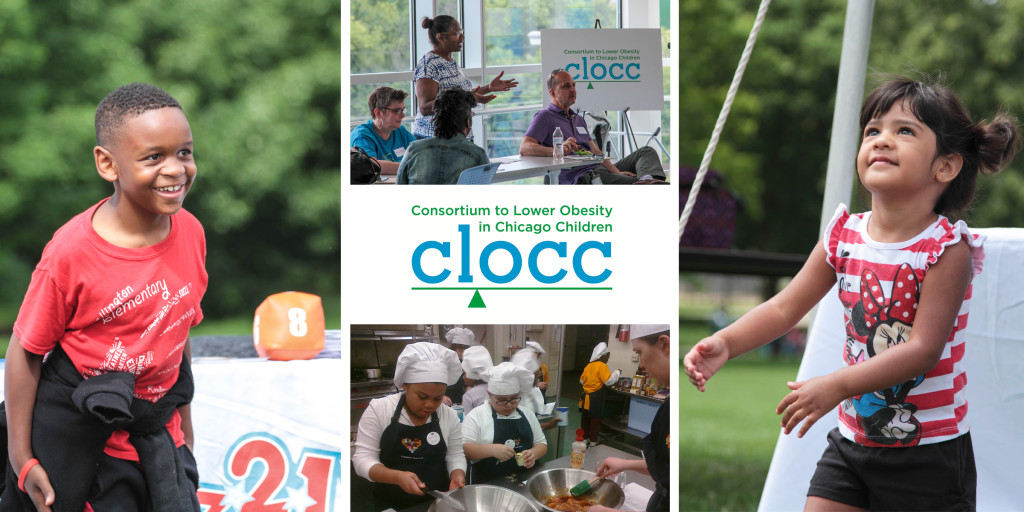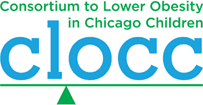
By Adam Becker, PhD, MPH
Executive Director, Consortium to Lower Obesity in Chicago Children
In 2017, CLOCC marked 15 years of collaborative learning and action to advance childhood obesity prevention in Chicago. We celebrated many successes, but we also learned that our battle has not yet been won. A recent study published in the New England Journal of Medicine uses pooled height and weight data from five nationally-representative longitudinal studies, with 176,720 observations from 41,567 children and adults and simulated growth trajectories across the life course. The study predicts that 57.3% of today’s children will be obese at age 35 and that half of the projected prevalence will occur during childhood. So, while current data suggests that rates are leveling off for children in general and declining among lower-income 2-4 year olds, the broad view of childhood obesity is still an alarming one.
Furthermore, we know that racial and ethnic disparities exist and are propagated by inequitable distribution of health-protecting and health-damaging environmental conditions where children live, learn, and play. In my keynote address to attendees at our December 2017 Quarterly Meeting, I shared these and other data showing how serious the childhood obesity epidemic continues to be. I presented summaries of Quarterly Meeting discussions, beginning in June 2016, in which together we identified strategies needed in CLOCC’s Blueprint areas to maintain our obesity-prevention momentum in Chicago. I reiterated our commitment as a consortium to advancing health equity as we continue to protect Chicago children from the devastating effects of early obesity.
A framework for advancing a health equity agenda, written by Dr. Shiriki Kumanyika’s and published by the New York Academy of Medicine in 2017, provides us with a high-level action plan of sorts that CLOCC’s leadership believes will move us forward. Dr. Kumanyika proposes four major categories of action: increase healthy options, reduce deterrents to healthy behaviors, build community capacity, and improve social and economic resources for individuals and families. If we take stock of CLOCC’s collective efforts and reflect back on that summary of our quarterly meeting discussions, we can be confident and proud that we have implemented myriad strategies to increase healthy options in Chicago. Together, we have improved access to healthy foods and beverages through farmers markets, corner stores, and machine vending. We continue to support a robust health and wellness initiative across Chicago Public Schools. We are working at the city and neighborhood levels to support active transportation policies and environmental change. We also had a major victory in 2014, when we helped the Illinois Department of Child and Family Services improve nutrition and physical activity in licensed childcare through new, evidence-based licensing requirements.
One of the challenges we recognize is that these successes are somewhat limited in scope and scale. In other words, while advances have been made, they aren’t necessarily being implemented equitably or sufficiently in all of the areas in Chicago where they are needed. So, there is work to be done – even in ongoing interventions. We’ve also put tremendous collective effort into building community capacity across Chicago. We have trained thousands of staff from community-based organizations to integrate 5-4-3-2-1 Go!® and fiveSMART® into their programming. We have shared innovative models for improving food access and linked consortium partners with this expertise to those who have an interest in learning. We have trained and supported community-based organizations to engage residents and audit streets and sidewalks for obstacles to walking and biking, and to utilize that audit data to push for change. We have helped our partners increase evaluation capacity and given childcare providers a fun and easy curriculum to teach young children about 5-4-3-2-1 Go!. And just having an opportunity once a quarter when a hundred-or-so CLOCC partners can be in the same room, learning together, networking, sharing information has increased capacity for obesity prevention across the city.
Unfortunately, we’re not doing nearly as well in reducing deterrents to healthy behaviors. While we have begun to confront the aggressive marketing of unhealthy foods and beverages to kids (and their caregivers) and we have seen healthy vending initiatives work to equalize price differentials between healthy and unhealthy foods, we still have a long way to go in these areas. We fought hard but ultimately missed an opportunity to make sweetened beverages a little more expensive through the repealed Cook County sweetened beverage tax; Efforts to pass a similar tax at the state level ultimately died as well. While we have explored key deterrents to healthy behaviors such as violence and threats to personal safety, and emotional health challenges like depression and anxiety, we have yet to lay out a clear direction as a consortium for addressing these and other factors that sometimes feel like they’re taking us out of our missions and areas of expertise. Dr. Kumanyika’s framework reminds us that we must continue to figure out how we will help reduce these significant obstacles that people in communities hardest-hit by the obesity epidemic confront every day. Her framework also pushes us in even more challenging directions with the fourth category of action: improve social and economic resources.
In December’s keynote presentation, I shared with the Consortium the preliminary work undertaken by CLOCC staff and the Executive Committee to explore four broad areas of social determinants and root causes of obesity: racism and immigration; segregation, poverty, and education; built environment deficiencies and the forces of gentrification that often accompany large-scale improvements; and violence, trauma, and stress. While these deeply-entrenched social problems may be shuffled and regrouped by others who are leading the way in thought and action, these categories helped us to explore the evidence about their links to health and obesity, identify the resources we have at our disposal as a consortium to lend our voice to their solutions, and begin to lay out “CLOCC-appropriate” pathways to get involved.
I truly believe that tackling these deterrents to healthy behaviors and improvements in social and economic resources is the “new frontier” for obesity prevention for us here in Chicago. Many CLOCC partners have been hard at work for many years and have developed significant expertise in addressing some of these issues that may, initially, seem to be quite removed from obesity prevention. We look forward to working with these partners to understand how an obesity prevention consortium can add fuel to the fire. It is our hope that in the near future we can share what we learn and we encourage those of you with ideas already in mind to share those ideas. The structures and processes that have been at the core of CLOCC’s activities for 15 years may evolve as we expand our worldview and our strategic approach may change – maybe even dramatically. I believe, however, that if we are to avoid the predicted statistic – that 57.3% of today’s children will be obese at 35 – then serious transformation in what we do and how we do it is imperative. We hope you will all join CLOCC staff and leadership as we explore this new and exciting frontier.

